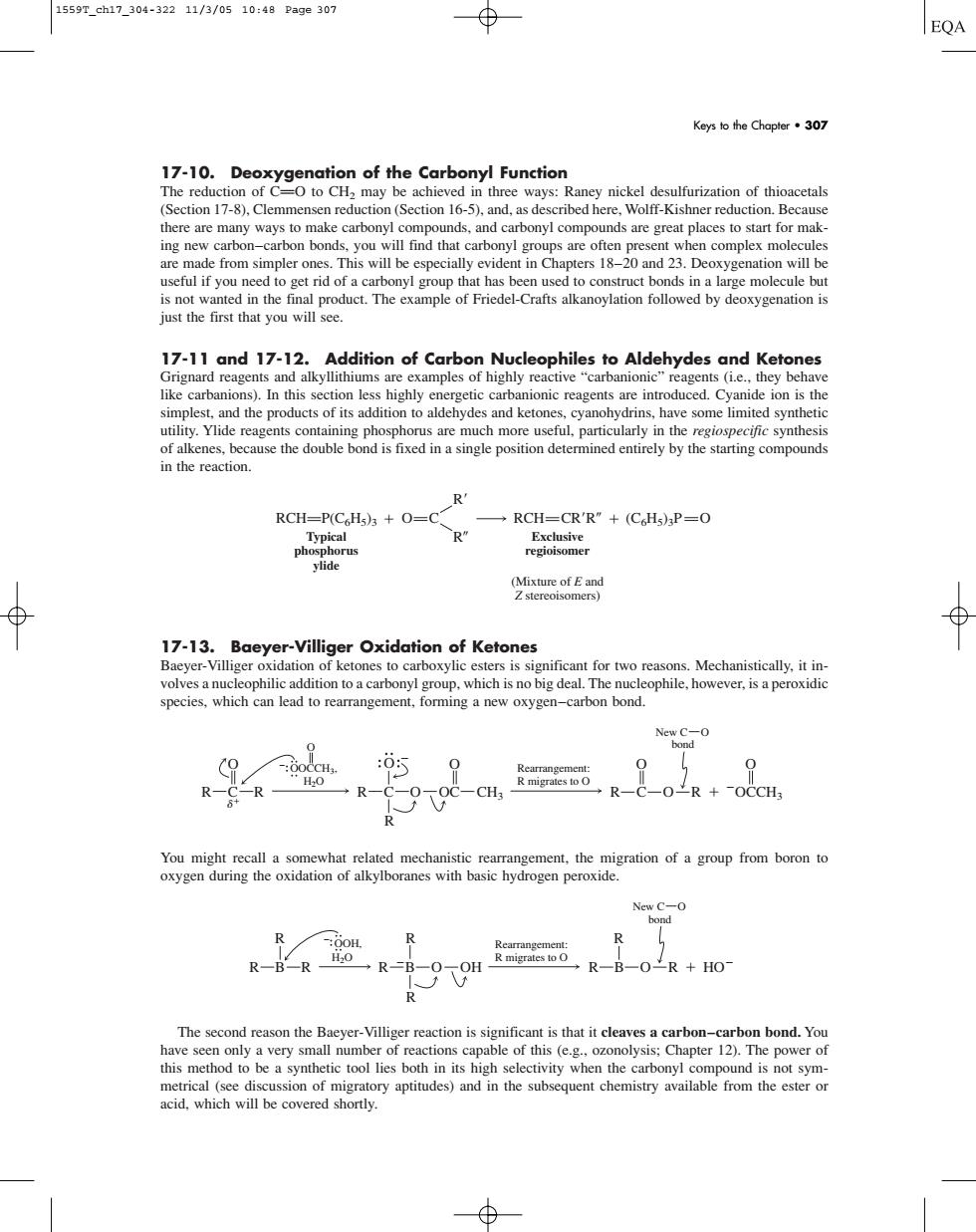正在加载图片...

1559Tch17304-32211/3/0510:49Page307 EQA Keys o the Chapter·3o7 17-10. Deo of the Carbonyl Function there are many ways to make carbonyl compounds.and carbonyl compounds are great places to start for mak ade arbon- bond 33 useful if you need to get rid of a carbonyl group that has been used to construct bonds in a large molecule but the fin you Addition of carh ergetic carbanionic reagents are introduced.Cyanide ion is the and ketone ve some limi in the reaction. R RCH=P( +0= R RCH =CR'R”+(CH)P=O 17-13.Baeyer-Villiger Oxidation of Ketones of ket You might recall a somewhat related mechanistic rearrangement,the migration of a group from boron to oxygen during the oxidation of alkylboranes with basic hydrogen peroxide New C0 R-B-0R+HO17-10. Deoxygenation of the Carbonyl Function The reduction of CPO to CH2 may be achieved in three ways: Raney nickel desulfurization of thioacetals (Section 17-8), Clemmensen reduction (Section 16-5), and, as described here, Wolff-Kishner reduction. Because there are many ways to make carbonyl compounds, and carbonyl compounds are great places to start for making new carbon–carbon bonds, you will find that carbonyl groups are often present when complex molecules are made from simpler ones. This will be especially evident in Chapters 18–20 and 23. Deoxygenation will be useful if you need to get rid of a carbonyl group that has been used to construct bonds in a large molecule but is not wanted in the final product. The example of Friedel-Crafts alkanoylation followed by deoxygenation is just the first that you will see. 17-11 and 17-12. Addition of Carbon Nucleophiles to Aldehydes and Ketones Grignard reagents and alkyllithiums are examples of highly reactive “carbanionic” reagents (i.e., they behave like carbanions). In this section less highly energetic carbanionic reagents are introduced. Cyanide ion is the simplest, and the products of its addition to aldehydes and ketones, cyanohydrins, have some limited synthetic utility. Ylide reagents containing phosphorus are much more useful, particularly in the regiospecific synthesis of alkenes, because the double bond is fixed in a single position determined entirely by the starting compounds in the reaction. 17-13. Baeyer-Villiger Oxidation of Ketones Baeyer-Villiger oxidation of ketones to carboxylic esters is significant for two reasons. Mechanistically, it involves a nucleophilic addition to a carbonyl group, which is no big deal. The nucleophile, however, is a peroxidic species, which can lead to rearrangement, forming a new oxygen–carbon bond. You might recall a somewhat related mechanistic rearrangement, the migration of a group from boron to oxygen during the oxidation of alkylboranes with basic hydrogen peroxide. The second reason the Baeyer-Villiger reaction is significant is that it cleaves a carbon–carbon bond. You have seen only a very small number of reactions capable of this (e.g., ozonolysis; Chapter 12). The power of this method to be a synthetic tool lies both in its high selectivity when the carbonyl compound is not symmetrical (see discussion of migratory aptitudes) and in the subsequent chemistry available from the ester or acid, which will be covered shortly. R R B R R R B O R HO H2O OOH, Rearrangement: R migrates to O R R R B O OH New C O bond O O R C R H2O OOCCH3, O Rearrangement: R migrates to O O R R C O OC CH3 O O R C O New C O bond R OCCH3 Exclusive regioisomer (Mixture of E and Z stereoisomers) O C R R RCH Typical phosphorus ylide P(C6H5)3 RCH CRR (C6H5)3P O Keys to the Chapter • 307 1559T_ch17_304-322 11/3/05 10:48 Page 307������